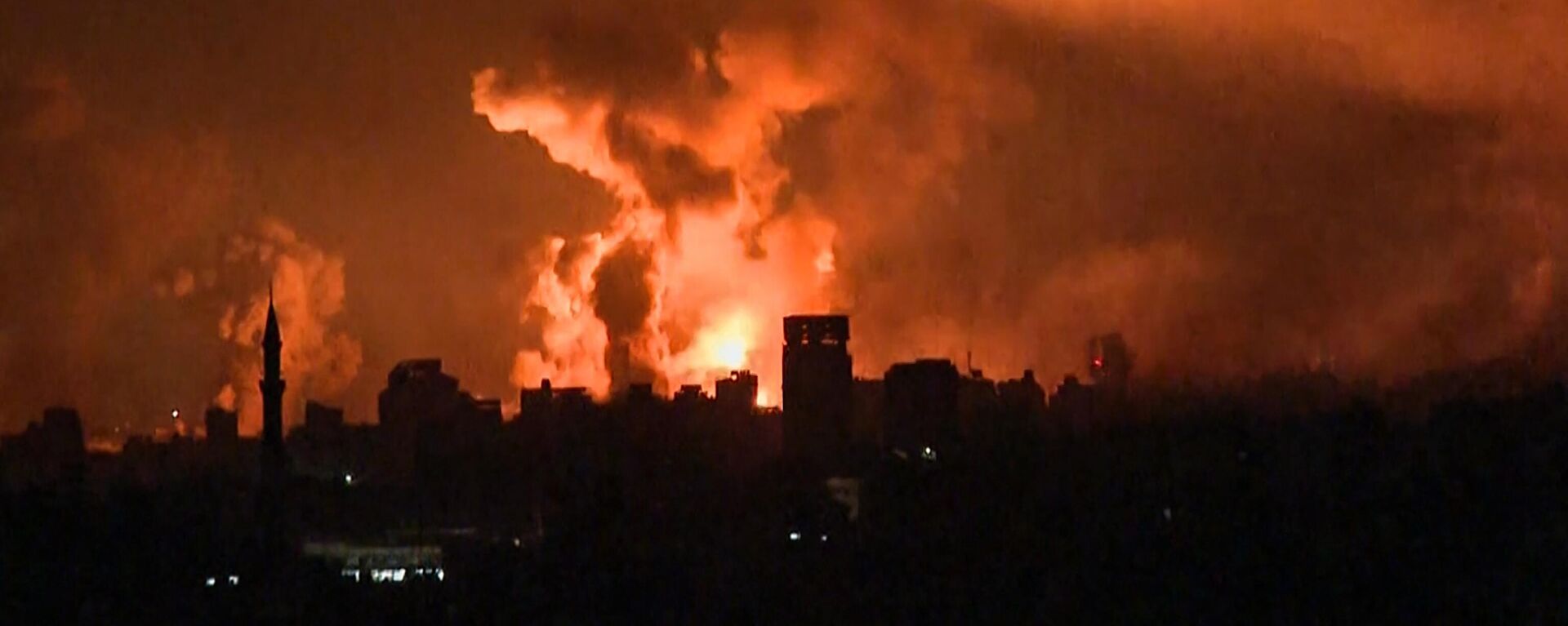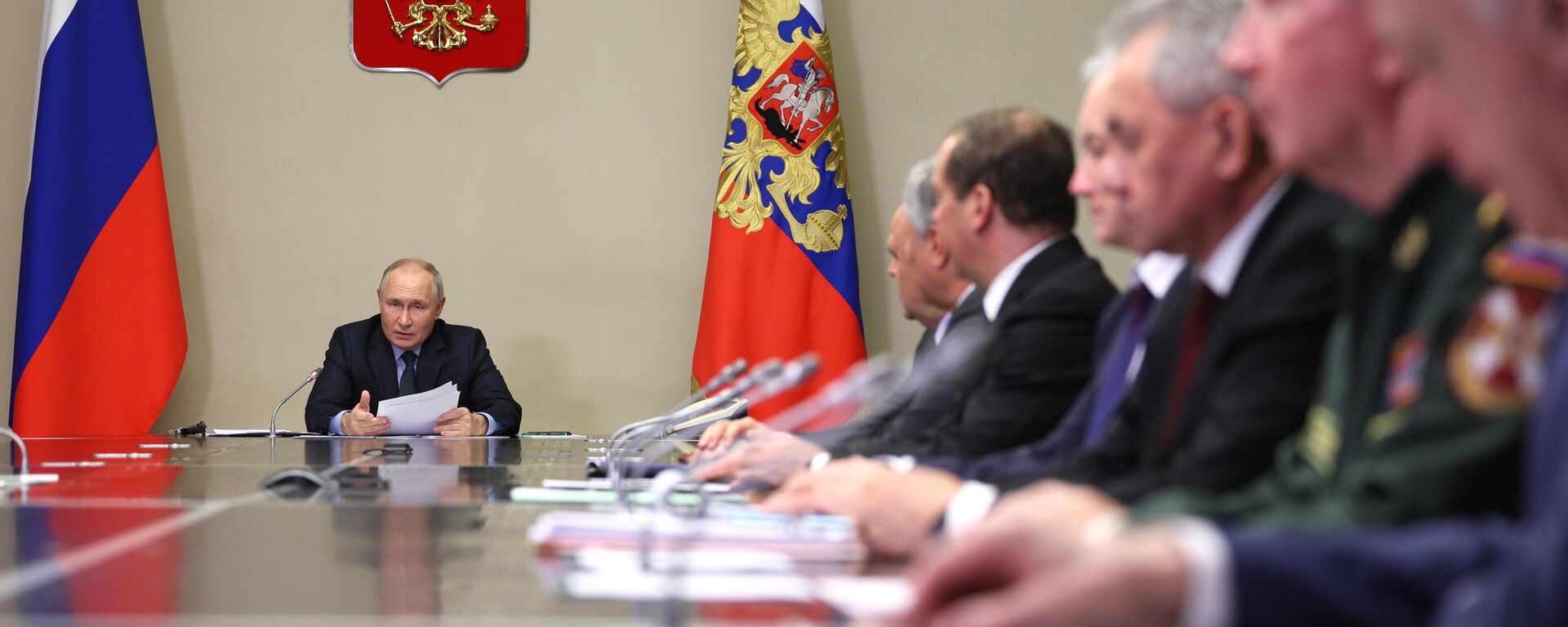https://en.sputniknews.africa/20231031/1063217825.html
Hamas May Use Rubble From Israel's Strikes as 'Shield' Protecting Gaza Tunnels - Expert
Hamas May Use Rubble From Israel's Strikes as 'Shield' Protecting Gaza Tunnels - Expert
Sputnik Africa
After pummeling the Gaza Strip with strikes that have gradually gained in strength, wreaking vast destruction upon the enclave and ratcheting up the civilian... 31.10.2023, Sputnik Africa
2023-10-31T11:04+0100
2023-10-31T11:04+0100
2023-10-31T11:04+0100
situation in niger after military coup
middle east
palestine
israeli-palestinian conflict
israel
gaza
united states (us)
hamas
israel defense forces (idf)
lloyd austin
https://cdn1.img.sputniknews.africa/img/07e7/0a/1f/1063218003_0:162:3066:1887_1920x0_80_0_0_aad05e7dfd0c65f74b9009708a1bb648.jpg
Hamas militant group can use the massive rubble and devastation in Gaza wrought by relentless Israeli bombardment as a “shell” to protect its infrastructure hidden in underground tunnels, Andrey Koshkin, a retired colonel and expert of the Association of Military Political Scientists, told Sputnik. After intense air strikes on Gaza following the Hamas attack on Israel on October 7, the Israel Defense Forces (IDF) expanded ground operations, with additional forces entering the pulverized enclave over the weekend.There have also been reports that Israel held off from a swift full-scale ground assault targeting Hamas in Gaza upon the advice of American officials, including Defense Secretary Lloyd J. Austin. Furthermore, Austin ostensibly pointed to the challenges of a ground invasion of Gaza, where Hamas has constructed a network of underground tunnels beneath populated areas.While in theory, the brick rubble resulting from Israeli strikes should offer protection for Hamas infrastructure in the tunnels, in practice it might be somewhat different, Andrey Koshkin acknowledged.At the same time, one should assume that when Hamas had those tunnels built, all the above-cited considerations were taken into account, added the pundit.The tunnels are three-tiered, said the expert, pointing out that the first level incorporates the communication passages that allow for movement of units, transfer of weapons and ammunition.“You can even drive a jeep through there,” Andrey Koshkin said.The second level accommodates workshops and factories for making Qassam missiles, went on the expert, while the third tier, somewhere at a depth of around 40-60 meters underground, conceals [Hamas] headquarters, which are protected by a concrete-reinforced cover.“Even concrete-piercing bombs won’t penetrate that," said Koshkin.Andrey Koshkin weighed in on speculations that the debris from the air strikes on Gaza might present a problem for the IDF in a ground operation.Israeli tanks had been seen on the outskirts of Gaza City, with the key road being cut off, media reported on Monday, citing eyewitnesses. Israel's Prime Minister Benjamin Netanyahu gave a televised address on Saturday night, telling the nation that the Israeli military had commenced the “second stage” of its war against Hamas militants in Gaza.“Last night, additional ground forces entered Gaza, marking the beginning of the second stage of the war, whose goal is to destroy the military and political capabilities of Hamas and to bring our kidnapped citizens back,” Netanyahu stated. He pointed to reports that three-star Marine Corps General James Glynn had departed the US to brainstorm Israel’s war on Hamas with Israel’s commanders. Glynn has experience of fighting in an urban setting in Iraq’s Fallujah, which had also been pulverized to a pile of debris, reminded the pundit.As for Israeli artillery and aviation, the debris is of no consequence, added the expert, stressing that the rubble was, in fact, the result of the work of artillery and aviation. Wreckage might pose certain difficulties for the infantryman crossing the terrain, or for moving tanks, he said, but if a tank needs to get through, there is the appropriate special equipment, bulldozers.In general, urban combat is the most difficult type, especially for armored vehicles, clarified the expert. Even the much-touted Israeli Merkava tanks can be burnt, and we heard reports that Hamas destroyed two such tanks after their attack on October 7, while ostensibly seizing another five or six. It is difficult to make maximum use of armored vehicles in the uban setting, said Koshkin.As for whether Israel will focus specifically on using long-range precision weapons when going after Hamas in Gaza, he reminded that this is a tactic the Americans had recommended, and the IDF will likely heed this advice.
https://en.sputniknews.africa/20231028/what-is-israel-expecting-from-current-conflict-1063136077.html
https://en.sputniknews.africa/20231031/us-needs-constant-chaos-in-middle-east-putin-1063211504.html
middle east
palestine
israel
gaza
united states (us)
Sputnik Africa
feedback@sputniknews.com
+74956456601
MIA „Rossiya Segodnya“
2023
News
en_EN
Sputnik Africa
feedback@sputniknews.com
+74956456601
MIA „Rossiya Segodnya“
Sputnik Africa
feedback@sputniknews.com
+74956456601
MIA „Rossiya Segodnya“
middle east, palestine, israeli-palestinian conflict, israel, gaza, united states (us), hamas, israel defense forces (idf), lloyd austin, benjamin netanyahu, war, conflict
middle east, palestine, israeli-palestinian conflict, israel, gaza, united states (us), hamas, israel defense forces (idf), lloyd austin, benjamin netanyahu, war, conflict
Hamas May Use Rubble From Israel's Strikes as 'Shield' Protecting Gaza Tunnels - Expert
After pummeling the Gaza Strip with strikes that have gradually gained in strength, wreaking vast destruction upon the enclave and ratcheting up the civilian death toll, Israel began a sequence of ground incursions into Gaza where Hamas utilizes a network of underground tunnels beneath densely-populated areas.
Hamas militant group can use the massive rubble and
devastation in Gaza wrought by relentless Israeli bombardment as a “shell” to protect its infrastructure hidden in underground tunnels,
Andrey Koshkin, a retired colonel and expert of the Association of Military Political Scientists,
told Sputnik. “The destruction caused by the IDF’s targeted strikes had transformed the rubble automatically into a protective “shield” of sorts. However, this cover has both advantages and disadvantages, as it can block exits and entrances… can destroy, to some extent, the communication infrastructure of those underground passages. But in general, of course, a pile of brick debris will offer a relatively reliable shell that will be hard to penetrate,” Andrey Koshkin said.
After intense air strikes on Gaza following the Hamas attack on Israel on October 7, the Israel Defense Forces (IDF) expanded ground operations, with
additional forces entering the pulverized enclave over the weekend.
“We are conducting expanded ground operations in the Gaza Strip. Ground forces, tanks, infantry, and armored forces are maneuvering towards terrorists,” said IDF spokesperson Rear Admiral Daniel Hagari on October 30.
There have also been reports that Israel held off from a swift full-scale ground assault
targeting Hamas in Gaza upon the advice of American officials, including Defense Secretary Lloyd J. Austin. Furthermore, Austin ostensibly pointed to the challenges of a ground invasion of Gaza, where Hamas has constructed a network of underground tunnels beneath populated areas.
While in theory, the brick rubble resulting from Israeli strikes should offer protection for Hamas infrastructure in the tunnels, in practice it might be somewhat different, Andrey Koshkin acknowledged.
“Piles of rubble from a destroyed multi-story building could offer cover, to some extent... But if an [Israeli] military commander decides to hit that part of the [Hamas] underground communications that they assume is under the debris, bombs will be used that can blast through the wreckage to reach the ground. After that, other bombs can be utilized,” said the expert.
At the same time, one should assume that when Hamas had those
tunnels built, all the above-cited considerations were taken into account, added the pundit.
The tunnels are three-tiered, said the expert, pointing out that the first level incorporates the communication passages that allow for movement of units, transfer of weapons and ammunition.
“You can even drive a jeep through there,” Andrey Koshkin said.
The second level accommodates workshops and factories for making Qassam missiles, went on the expert, while the third tier, somewhere at a depth of around 40-60 meters underground, conceals [Hamas] headquarters, which are protected by a concrete-reinforced cover.
“Even concrete-piercing bombs won’t penetrate that," said Koshkin.
Andrey Koshkin weighed in on speculations that the debris from the air strikes on Gaza might present a problem for the IDF in
a ground operation.
Israeli tanks had been seen on the outskirts of Gaza City, with the key road being cut off, media reported on Monday, citing eyewitnesses. Israel's Prime Minister Benjamin Netanyahu gave a televised address on Saturday night, telling the nation that the Israeli military had commenced the “second stage” of its war against Hamas militants in Gaza.
“Last night, additional ground forces entered Gaza, marking the beginning of the second stage of the war, whose goal is to destroy the military and political capabilities of Hamas and to bring our kidnapped citizens back,” Netanyahu stated.
“They talk about expanding the operation, but in reality they are filling [the Gaza strip] with armored vehicles. The fact is that the Americans recommended that they carry out targeted strikes, and conduct special forces raids based on targeted strikes. That is what they [US military] did in Iraq,’ Andrey Koshkin said.
He pointed to reports that three-star Marine Corps General James Glynn had departed the US to brainstorm Israel’s war on Hamas with Israel’s commanders. Glynn has experience of fighting in an urban setting in Iraq’s Fallujah, which had also been pulverized to a pile of debris, reminded the pundit.
“For armored vehicles, rubble and debris matters. Of course, this is a battle in the city, amid destroyed buildings. There is special equipment that can clear lateral routes from rubble… But in some places, yes, the debris will present a certain obstacle. But this obstacle will also be perceived as a building in which Hamas is holed up, and whether to break through it or not, or to take out snipers with precision strikes - this will be decided tactically, on the spot," said Koshkin.
As for Israeli artillery and aviation, the debris is of no consequence, added the expert, stressing that the rubble was, in fact, the result of the work of artillery and aviation. Wreckage might pose certain difficulties for the infantryman crossing the terrain, or for moving tanks, he said, but if a tank needs to get through, there is the appropriate special equipment, bulldozers.
“If suddenly they determine that [Hamas] leaders are hiding under the rubble … then they [Israeli military] will use gliding high explosive bombs which will sweep away the debris, and destroy underground infrastructure. Yes, the obstructions exist, but to claim that they present a protective cover for Hamas, and an obstacle for the IDF would not be entirely correct,” Andrey Koshkin surmised.
In general, urban combat is the most difficult type, especially for armored vehicles, clarified the expert. Even the much-touted Israeli Merkava tanks can be burnt, and we heard reports that Hamas destroyed two such tanks after their attack on October 7, while ostensibly seizing another five or six. It is difficult to make maximum use of armored vehicles in the uban setting, said Koshkin.
As for whether Israel will focus specifically on using long-range precision weapons when going after Hamas in
Gaza, he reminded that this is a tactic the Americans had recommended, and the IDF will likely heed this advice.
“They will attack with aircraft, they will attack with artillery, they will shoot from tanks, they will burn everything they can burn before the infantrymen enter,” Andrey Koshkin concluded.



